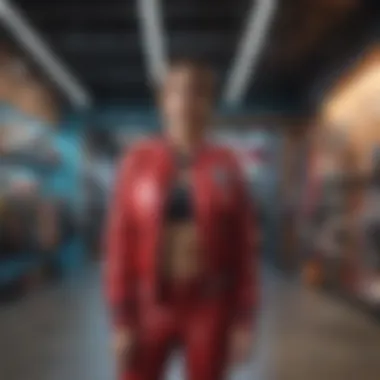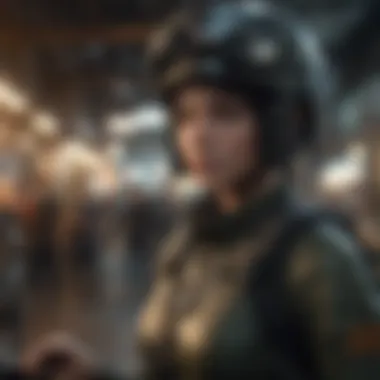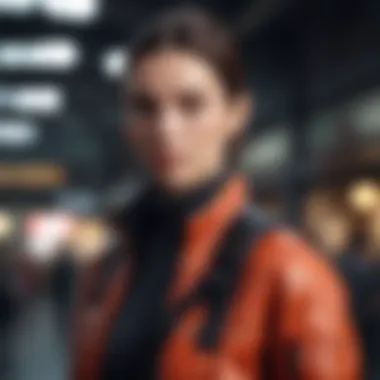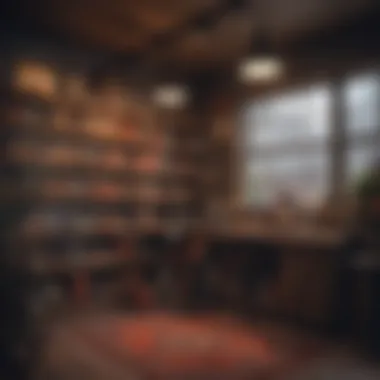Discover Unique Indie Fashion Retail Spaces


Intro
In a world saturated with fast fashion and mass production, indie fashion emerges as a refreshing alternative. The indie fashion scene thrives on individuality, creativity, and distinctiveness. It encompasses a broad spectrum of styles, materials, and designs, often reflecting the values of sustainability and ethical practices. Recognizing the importance of this niche, indie fashion provides not just clothing but an entire lifestyle, resonating with consumers who prioritize personal expression over conformity.
In this guide, we explore niche retail spaces, both in physical locations and online platforms, where unique indie fashion thrives. As consumers increasingly lean towards supporting independent designers and concepts, discovering these gems becomes essential. Whether you prefer the tactile experience of small boutiques or the convenience of digital marketplaces, the aim is to equip readers with the knowledge to navigate these diverse spaces confidently.
Indispensable Indie Fashion Hotspots
Indie fashion shops reflect a harmonious blend of culture, creativity, and community. These spaces invite shoppers to explore the works of emerging talents and established artisans alike. Therefore, it is vital to identify where to find these unique retail experiences.
Local Boutiques
Independent boutiques offer a personal touch that large retail chains often lack. Each boutique typically curates its collection, presenting a thoughtful selection of garments ranging from handmade pieces to ethically sourced materials. The ambiance of boutiques can greatly enhance the shopping experience. Store owners often possess intimate knowledge of their products, allowing for tailored recommendations.
Online Marketplaces
The digital age has transformed shopping habits. Platforms such as Etsy and Depop have opened doors for independent designers to reach audiences worldwide. These websites enable consumers to discover handcrafted items or vintage finds, bridging geographical gaps in the fashion world. Online marketplaces also foster community relationships, empowering buyers to connect directly with creators.
Collaborative Events
Pop-up shops and fashion fairs offer an engaging avenue for discovering indie fashion. These events usually feature multiple designers under one roof, providing an opportunity for small brands to showcase themselves. Additionally, such occasions create a vibrant marketplace atmosphere, often incorporating live music and art, which attracts diverse visitors seeking inspiration and connection within the indie fashion community.
"Indie fashion is not just about aesthetics; it emphasizes unique storytelling through each piece."
Significance of Supporting Indie Fashion
Opting for indie fashion goes beyond personal style. Supporting independent designers fosters local economies and promotes ethical practices. Indie fashion typically involves lower production scales, which can result in reduced environmental impact. Each purchase contributes to a holistic ecosystem of creativity, individuality, and conscious consumerism. Additionally, the support of indie designers allows them to thrive against mass-produced alternatives, ensuring a rich diversity in the fashion landscape.
Prelude to Indie Fashion
Indie fashion represents a vibrant subculture that flourishes outside the mainstream fashion framework. This segment of the fashion industry is characterized by its emphasis on individuality and originality. The clothing produced within this niche often reflects personal stories, artistic expression, and a commitment to unique style that mass-produced items cannot emulate. As more consumers seek to distinguish themselves in the fashion landscape, indie fashion gains traction for its unparalleled offerings.
In this article, we will explore various retail spaces that cater to indie fashion enthusiasts. Understanding the essence of indie fashion and its implications for the retail environment is essential for recognizing where to find valuable pieces. Supporting these independent designers and brands is not merely about supplying a wardrobe; it is a statement about values, aesthetics, and community.
This article will delve into both physical and online venues where unique fashion can be discovered. Local boutiques, pop-up shops, thrift stores, and designer showrooms will be examined alongside dedicated online platforms. Each space offers specific advantages, allowing consumers to engage with fashion in a meaningful way. As we traverse this landscape, we will also highlight the importance of supporting small, independent designers who contribute fresh perspectives and diversify the fashion market.
Defining Indie Fashion
Indie fashion refers to clothing that is produced by independent designers and small brands rather than large corporations. This movement emerged as a response to the homogeneity of mass-market fashion, with many consumers becoming disillusioned by the lack of creativity and innovation. Indie fashion values craftsmanship, often featuring sustainable practices and ethical production. The focus is on design that prioritizes uniqueness and quality over quantity.
Indie pieces often come from smaller workshops, allowing designers to maintain control over materials and manufacturing processes. This results in garments that embody a sense of personality and connection, as well as a narrative that resonates with wearers. Each item, therefore, becomes more than just an article of clothing; it reflects the ethos of the designer and the influences that shape their work.
Significance of Supporting Independent Designers
Supporting independent designers is significant for several reasons. First, engaging with indie fashion promotes diversity within the industry. Independent creators bring fresh ideas that challenge conventional trends and aesthetics, contributing to a broader and more enriching fashion dialogue.
Second, by purchasing from small brands, consumers actively participate in the economic sustainability of local and independent enterprises. This can help fuel innovation and creativity in the industry by ensuring that designers receive the recognition and financial support they need to grow.
Lastly, choosing to support indie fashion aligns with a commitment to sustainability. Many independent designers prioritize eco-friendly materials and ethical practices. By opting for their products, buyers contribute to a more responsible fashion ecosystem, one that values not just appearance but also the impact on the environment and society.
Supporting indie fashion isn't just about unique style. It's a statement about values, sustainability, and the importance of originality.
Physical Retail Spaces


Physical retail spaces are crucial to the indie fashion landscape. They represent tangible realms where independent designers can showcase their work and forge direct connections with consumers. Unique venues, ranging from local boutiques to pop-up shops, provide a stage for creativity and distinctiveness. These spaces allow patrons to experience products first-hand, examine materials, and engage in thoughtful discussions with shop staff.
Shopping in a physical store often offers a sensory experience that online shopping cannot replicate. The energy of the space, the layout, and even the fragrance of the store can influence customer choices. Physical retail spaces also foster community ties, as they often rely on local customer bases and contribute to the local economy.
Local Boutiques
Identifying Unique Offerings
Local boutiques play a significant role in indie fashion. They select pieces that usually reflect the local culture and trends. The key characteristic of these boutiques is their commitment to curating collections that feature one-of-a-kind items, not mass-produced clothing. This individuality makes them a beneficial choice for those seeking unique designs.
The advantage of identifying unique offerings at local boutiques is the personal touch they provide. Many boutiques have established relationships with local artists, allowing them to showcase pieces that might not be available elsewhere. This creates a sense of distinction for shoppers. However, the limited inventory can be a drawback—customers may find it challenging to get multiple sizes or styles in one visit.
The Role of Community in Local Fashion
Community is vital for local boutiques. They often serve as hubs for fashion enthusiasts to collaborate and share ideas. The key characteristic of this community aspect is engagement. Boutiques organize events that bring together designers, customers, and artists.
This role of community can be beneficial in nurturing loyal customer bases. Customers often prefer shopping locally and supporting designers they know or have met. However, the reliance on local affiliations may restrict the reach of these boutiques, limiting their ability to attract a broader audience.
Tips for Discovering Hidden Gems
Finding hidden gems in local retail spaces is essential for a rewarding shopping experience. Key characteristics of this discovery process include exploration and curiosity. Visiting neighborhoods not known for shopping can lead to surprising finds.
This approach is beneficial as it encourages shoppers to think outside conventional shopping zones. Engaging with locals can also provide insights into the best spots for unique pieces. On the downside, fewer people may frequent less-known areas, making these spots less vibrant or lively than larger retail districts.
Pop-Up Shops
Understanding the Pop-Up Concept
Pop-up shops offer a fresh model for indie designers to reach consumers. These are temporary retail spaces that can appear in various locations, creating excitement and urgency among shoppers. The key characteristic is their transient nature, making them a popular choice for launching new collections or creating buzz.
The pop-up concept is beneficial for indie fashion as it encourages experimentation. Designers can test new markets with lower overheads compared to permanent retail spaces. However, consumers need to be timely, as missing a pop-up could mean missing a unique buying opportunity.
Events and Collaborations in Indie Fashion
Events and collaborations are central to the pop-up experience. Key aspects include themed events that showcase multiple designers, allowing for community engagement. Such collaborations enable indie designers to pool resources and benefit from each other's audiences.
The collaborative nature of these events enriches the indie fashion scene. Shoppers benefit from a diverse offering in a single location. Yet, the focus on events can lead to competition among designers, making it essential for them to stand out in a crowded marketplace.
Benefits of Shopping at Pop-Up Events
Shopping at pop-up events allows customers to experience the latest trends directly from designers. The atmosphere typically buzzes with creativity and excitement, which enhances the shopping experience. This characteristic of immediacy drives sales and encourages impulse buying.
The unique feature of shopping at such events is the opportunity to converse with designers. This creates a personal shopping experience and promotes brand loyalty. However, the downside can be the unpredictable nature of pop-up locations; shoppers may need to frequently check for updates to stay informed about schedule and availability.
Thrift Stores and Vintage Shops
Finding One-of-a-Kind Pieces
Thrift stores and vintage shops offer a unique adventure for finding one-of-a-kind pieces. A key aspect is their ever-changing inventory, which reflects different eras and styles. This variety makes them a popular choice for those who truly seek unique fashion statements.
The advantage of shopping at these stores is affordability. Shoppers can often find high-quality items at low prices compared to traditional retail. However, the drawback may include the time investment; searching through racks requires patience and a discerning eye.
The Sustainable Fashion Movement
The sustainable fashion movement significantly influences thrift and vintage shopping. The growing awareness of environmental concerns has led consumers to consider their purchasing habits seriously. The key characteristic of this movement is its promotion of sustainability as a desirable attribute in fashion.


By participating in thrift shopping, consumers support a circular fashion economy, reducing waste while still creating unique styles. This conscious approach can enhance one's sense of responsibility towards the environment. Yet, this emphasis on sustainability can sometimes lead to a perception that thrifted items are inferior or less stylish, which is not the case.
Knowledgeable Staff and Their Impact
Knowledgeable staff in thrift stores and vintage shops can enhance the shopping experience. Key characteristics include passion and expertise in fashion history. Staff can offer valuable insights about pieces and help customers make informed choices.
This assistance can be particularly beneficial for those unfamiliar with vintage trends, making it easier to navigate options. However, not all thrift store staff may possess extensive knowledge, which can affect the quality of guidance shoppers receive.
Designer Showrooms
Connecting with Small Brands
Designer showrooms provide a platform for small brands to display their work directly to consumers. The primary characteristic of these spaces is exclusivity; they often feature limited collections not widely available in retail.
Connecting with small brands is beneficial for consumers looking for unique styles. Customers can often purchase directly from the designer, ensuring a personal touch. However, this exclusivity may come at a higher price point, which can deter some potential customers.
The Experience of Personal Shopping
Shopping in designer showrooms often includes a personalized experience. Individual attention usually means that staff can assist customers based on their preferences and body types. This characteristic enhances customer satisfaction and can lead to loyalty.
The advantage of this experience is the tailored advice and selections available. Customers often leave feeling more knowledgeable about their purchases. On the downside, this intimate environment may not suit shoppers who prefer a more independent, self-guided approach.
Understanding Collections and Lookbooks
Designer showrooms may offer collections and lookbooks that showcase a brand's vision. This feature allows customers to see the story behind the pieces and visualize how they fit into broader trends. The key characteristic is cohesion, ensuring that all pieces complement one another.
Understanding collections and lookbooks can be beneficial for consumers looking to invest in timeless pieces. This informed approach can lead to more thoughtful purchases. However, not all shoppers may appreciate or understand the narrative, which can affect their engagement with the collection.
Online Shopping Platforms
The role of online shopping platforms has become increasingly important in the realm of indie fashion. They serve not just as a marketplace, but as a bridge connecting independent designers to a wider audience. With the scalability that digital platforms provide, these spaces help small brands promote their unique styles and gain visibility in a crowded market. Online shopping enables consumers to access indie fashion from anywhere in the world, making it a vital component of the shopping experience.
Dedicated Indie Retail Websites
Features of Prominent Indie Fashion Sites
Popular indie fashion websites often share specific features that enhance user experience. One key characteristic is the carefully curated selection of products. These sites typically focus on quality over quantity. This ensures shoppers find unique pieces that stand out from mainstream retail offerings. Furthermore, many of these platforms include detailed product descriptions, highlighting the design process and the story behind each item, which adds value to the shopping experience.
Community Reviews and Feedback
Community reviews and feedback play a significant role in online shopping for indie fashion. This interactive element allows shoppers to share their experiences, which in turn guides new customers in their purchasing decisions. User-generated content enhances credibility, making it more likely for a potential buyer to trust the quality of a product when they see positive reviews. Moreover, feedback can help designers understand the market better, leading to improved future offerings.
Shopping Trends in the Indie Scene
Shopping trends within the indie scene fluctuate and evolve frequently. A key highlight is the demand for sustainable fashion, as many consumers are becoming increasingly eco-conscious. This trend has contributed to the rise of brands that use recycled materials and ethical production methods. Understanding these trends helps consumers make informed decisions and supports designers who align with their values. Additionally, tracking these trends can reveal innovative styles and concepts, keeping shoppers engaged with the indie fashion landscape.
Etsy and similar Marketplaces
The Global Reach of Indie Sellers
Etsy and similar marketplaces facilitate a remarkable global reach for indie sellers. This characteristic is vital for independent designers who might otherwise struggle to find a customer base. By allowing artisans from different corners of the world to sell their creations, these platforms enable diverse collections to flourish. Customers benefit from this diversity, discovering unique styles that reflect various cultures and trends. This global aspect solidifies the importance of platforms like Etsy in connecting buyers with niche markets.
Curating Your Shopping Experience
Curating your shopping experience is an essential feature of marketplaces like Etsy. The ability to follow favorite sellers and receive personalized recommendations enhances the overall experience. Shoppers can save items for later, which allows them to explore their options before committing to a purchase. This personalized approach not only makes shopping more enjoyable but also helps in building a loyal customer base for indie brands.


Supporting Artisans and Craftspeople
Supporting artisans and craftspeople is a key reason many consumers choose to shop on marketplaces such as Etsy. By purchasing handmade items, shoppers contribute to the livelihood of independent creators. This direct support contrasts sharply with larger retail chains, where customer dollars may not have the same positive impact. Furthermore, it fosters a sense of community among makers and buyers, encouraging collaboration and innovation in the indie fashion sector.
Social Media Marketplaces
Platforms for Indie Merchants
Social media platforms have increasingly become vital marketplaces for indie merchants. Sites like Instagram and Facebook provide a unique opportunity for designers to showcase their work visually. This effective marketing strategy lures potential customers with eye-catching images of fashion items in dynamic contexts. Additionally, these platforms often feature easy purchasing options, allowing users to buy directly from their favorite posts. This immediacy is one reason why social media is popular for indie fashion shopping.
The Influence of Influencers
The influence of influencers has a significant impact on the indie fashion market. Many independent brands collaborate with social media influencers to reach wider audiences. By leveraging the trust that influencers have built within their communities, brands can gain visibility and credibility. However, it is important to evaluate the authenticity of influencer partnerships, as not all align perfectly with a brand's ethos. Consumers need to discern genuine endorsements from merely paid promotions.
Community Building through Fashion
Community building through fashion is another essential aspect of social media marketplaces. These platforms can foster connections between customers and creators, enhancing loyalty and engagement. Social media allows customers to share their purchases, creating an opportunity for word-of-mouth marketing. This organic promotion can help indie brands grow without significant advertising budgets. Ultimately, this sense of community enriches the overall shopping experience and supports small businesses emotionally and financially.
Events and Collaborations
Events and collaborations serve an essential role in the indie fashion landscape. They bring together designers, consumers, and other stakeholders, creating a vibrant ecosystem that thrives on creativity and community engagement. Through these events, independent labels can showcase their work, while shoppers have the chance to discover unique pieces that reflect individual style. These gatherings emphasize personal connection and authenticity, essential elements in supporting indie designers and fostering a rich fashion culture.
Fashion Markets and Festivals
Highlighting Local and Emerging Designers
Highlighting local and emerging designers is crucial. These events often feature collections from up-and-coming talent who may lack visibility in more prominent retail spaces. Showcasing these designers allows them to gain exposure while enriching the local fashion scene. Local events create a supportive environment where new ideas thrive, and designers can experiment without the constraints typically found in larger retail settings. This emphasis on local initiatives fosters a sense of pride and develops community bonds.
Networking Opportunities
Networking opportunities at fashion markets and festivals facilitate meaningful connections. Designers can meet potential retailers, collaborators, and even influencers who are essential in promoting their work. These interactions help build relationships that may lead to future collaborations and partnerships. The casual yet productive atmosphere at these events encourages conversations that might otherwise never happen, enabling fresh ideas to emerge.
Exploring Trends in Live Environments
Exploring trends in live environments provides insight into consumer preferences and emerging styles. Fashion markets allow attendees to see firsthand how trends manifest in real-time. This immediacy helps both designers and consumers understand shifts in popular culture, offering a unique lens through which to view the evolving landscape of fashion. When trends are experienced in person, it creates a deeper understanding that cannot be replicated online.
Creative Collaborative Events
Building Community Through Creativity
Building community through creativity is at the heart of indie fashion events. Collaborations among designers, artists, and creators lead to innovative projects that push boundaries and redefine norms. When individuals come together to share their visions, the result is often greater than the sum of its parts. This collaboration fosters a supportive culture where talents can flourish, and diverse voices are heard.
Engagement with the Indie Fashion Community
Engagement with the indie fashion community enriches the shopping experience. By participating in events, consumers feel more connected to the brands and designers they support. This sense of belonging enhances loyalty and motivates shoppers to explore indie fashion deeply. Engaging directly with the community fosters a culture of support for local businesses that might go unnoticed otherwise.
Impact on Individual Brands
The impact on individual brands through these collaborative efforts cannot be overstated. Participation in events elevates brand visibility and establishes an identity in the crowded fashion marketplace. Independent designers can differentiate themselves through unique offerings and styles, which becomes possible through collaborations and community engagements. However, there is also a risk that not every collaboration fits seamlessly, and brands must learn to navigate these partnerships thoughtfully.
Epilogue
In this exploration of unique retail spaces, it becomes evident that the realm of indie fashion holds remarkable opportunities for both shoppers and designers. The various venues, from local boutiques to online platforms, serve as crucial touchpoints that foster creativity and individuality. As consumers increasingly seek authenticity in their fashion choices, the significance of supporting independent designers cannot be overstated.
The Future of Indie Shopping
The future of indie shopping is bright and evolving. With an increasing consumer awareness regarding sustainability and ethical practices, indie brands are positioned to flourish. Here are some key elements shaping this landscape:
- Growth of Localism: Many shoppers are shifting their focus to local businesses, seeking connections with their community.
- Digital Innovation: Platforms tailored for indie fashion are enhancing user experience. This includes providing personalized recommendations and creating interactive shopping experiences.
- Sustainability Trends: More shoppers are looking for eco-friendly options. Indie brands often prioritize sustainable materials and practices, resonating with environmentally conscious consumers.
- Collaborative Projects: The rise of collaborative events invites increased participation and supports various artisans, creating a stronger network.
In summary, indie fashion is more than just a trend; it represents a movement toward individuality, sustainability, and community engagement. The more consumers embrace this unique retail space, the more vibrant the indie fashion scene will become.







